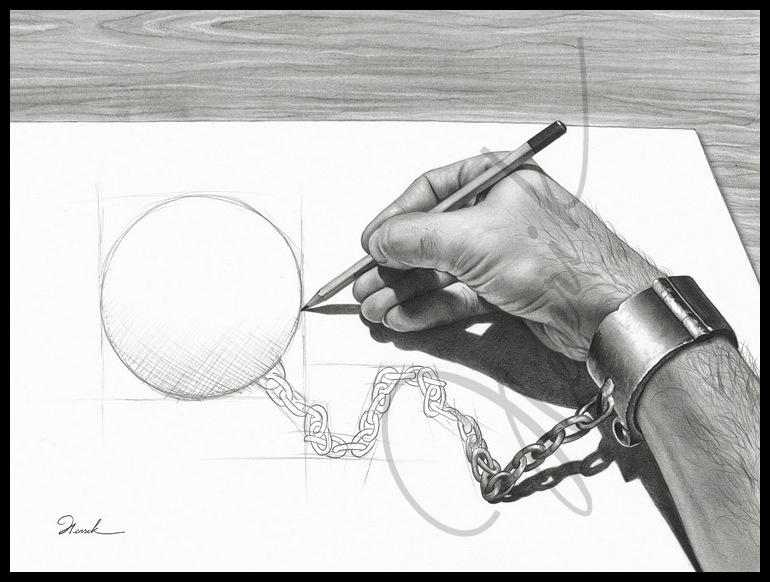That is probably what Mc Escher was trying to portray in his work as shown below.
 |
| Escher, MC. "Reptiles". Lithograph. 1943. |
In the lithography by Escher, it depicts a opened up sketchbook, with a half drawn page featuring his abstract tessellation of reptiles. The surroundings are scattered with miscellaneous objects such as plants, books, bottle, cups and a polygonal 3-D object. From the illustrated tessellation in the sketchbook, the reptiles seem to gradually materialise into its form from the bottom left hand corner of the illustration. One by one, it seemingly emerges from the illustration and climbs upon the other objects around, going in a cyclical motion. The reptiles then eventually crawl over the book, the cup and the polygonal object in a circle, back into the illustration where the reptile is once again gradually integrated back into it's 2-Dimension form.
The lithography is completely black and white, with a centered composition where all the subject matters are focus in the middle. The viewer's perspective seems to come from above, watching as the surrealistic progression of vision and reality taking place. Escher has also made use of the forms and style to depict the 'real' reptiles and the illustrated reptiles respectively. While the illustrated reptiles are simply static, fixed in their positions with their forms delineated by straight rigid lines with little details, when it comes into reality, the reptiles looks increasiangly realistic with smoother and more intricate lines of details that depicts it's scales and body parts. Furthermore, with the play of highlights and shadows, Escher had effectively distinguished the real and the illustrated and the real reptiles.
In this work, while the mood seems to be dulled by the monotonous colours, it also seems to have a lively note. This liveliness is brought about by the motion of the reptiles in their cyclical motion around the artwork. It can be also seen to be slightly eerie as it is surreal to have reptiles emerging from illustrations and moving about.
For me, what makes this incredibly fascinating and surreal is how the artworks are depicted to come into life. Furthermore, he had managed to keep every other object in accurate scale, as if everything were perfectly realistic. The transition from illustration to real reptiles were also very intricately and carefully done such that there is a visible transition which is gradual, making the unrealistic look much more realistic.
Overall, by the positioning of limbs of the reptiles, it seems to have a sense of rhythm as it crawls over the objects back into the illustration. It shows a surrealistic scene of an illustration coming into life and the reverse as it continues on in an eternal cycle.
 |
| Moses, Henrik, "Prisoner of my own". Graphite. 2006. |
This work is done by an Artist I had come across in Deviantart a few years back. As I saw Escher's Reptiles, I was inevitably reminded of this work. Both of them had shared the equally fascinating concept of illustrations and reality, and had successfully depicted them on paper. The overarching similarity is how the illustrations in both artworks shows how the illustration comes into life and how both elements are seemingly intertwined.
What would be different is that in 'Reptiles', the integration and disintegration goes both ways in a cycle, while in the 'Prisoner of my own', the transition only goes one way in terms of the transition between drawing and reality. However, there is an extra element of twist in 'Prisoner of my own' where the hand, which is the main subject matter whose chains are emerging from the drawings is the same hand that is used to draw the weight that would be imprisoning him. In a way, there is a different form of cycle present in 'Prisoner of my own'
Both works include such incredulous concepts that breaches between our mere visions and reality. Such surrealism can also be put to symbolism as done in 'Prisoner of my own'. Perhaps I could keep such a concept in mind for future inspirations!
Above is a video done by someone in correspondence to the work 'Reptiles' by MC Escher. Here, he/she had actually animated the entire process of the artwork becoming into reality. This way we could possibly see the motion version of what Escher had had in mind then. This will provide an interesting perspective to how we can further view this work and see it in motion. 


